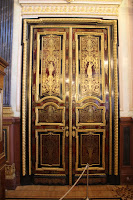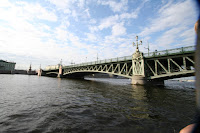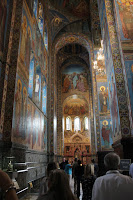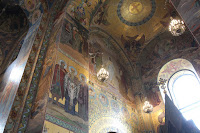So we struggled with how to blog
about St. Petersburg. There was so much to see and the history behind the
things we saw was so rich and deep that it would have taken a couple of weeks
to sort everything out and write about it in our usual manner.
 |
| Russian apartments |
 |
| Coming into St. Petersburg |
It is virtually
impossible to remember all the rooms, buildings, works of art and the stories
behind them to do the blog justice. And there was overlap among the 3 shore excursions
we took to add to the confusion. We decided that it would be best to give what
overview we could on each subject and let the some of the 448 pictures we took
of the city speak for themselves.
 |
| More apartments |
This segment is being posted post-trip,
because there was no possible way that the ship’s crippled internet service
would have allowed so much data to be uploaded in a timely manner. It would
often take an hour or more to upload, say 30 mb of data. If you find a subject
interesting, we encourage you to search for more information.
 |
| St. Petersburg |
Early the next morning our pilot
guided our ship through a long canal that approaches St. Petersburg's new
cruise terminal which opened five years ago. We were docked and the gangplank was
in place by 0700, as the shore excursions were ready to begin. Today our
excursion was to the Hermitage, the famed art museum that is housed in the
Winter Palace. But before anything happened, we had to clear Russian passport
control. Two nights before we arrived in Russia, the shore excursion manager
warned us to have our Russian shore excursions booked, since the ship had to
provide a manifest to the immigration authorities indicating who was coming ashore.
If your name wasn’t on that list, you weren’t going ashore unless you had an
individual visa (something that’s a real pain to get). By booking through the ship, we could go
ashore under a blanket visa, but we had to remain with the guide at all times. The
shore excursion manager laid down a challenge: try to get your agent a passport control
to smile. We queued up at the control booths and waited our turn. Finally, we
came face to face with a stern-faced agent who examined our passport and us for
at least 20 seconds, but which seemed a lot longer. Apparently having dotted
all of the i’s, our passport was stamped and we proceeded to our bus, but
without a smile. As we started out of the parking lot, someone commented about
the Russians always stamping the U.S. passports on page 24. We checked ours, and sure
enough, like everyone around us, the passports were stamped on page 24.
Everyone was speculating as to why this was their practice, but Capt. Larry thought he
had the answer. Page 24 in U.S. passports has an illustration of a bear catching
a salmon in a stream, and he thought this might be a subtle way of reminding us
of the power of the “Russian bear.”
Formerly known as
Petrograd and later Leningrad, St. Petersburg is Russia’s most modern city and
the cultural capital for all of Russia. The city has 5 million inhabitants. As we rode through St. Petersburg
and realized that this going to be perhaps, the most overwhelming display of
art and architecture we had ever seen. As we arrived at the Hermitage, our
guide warned us about pick pockets, and led us inside. These are some of the
displays we saw:
 The Hermitage
The Hermitage
 |
| The Throne Room |

 |
A mosaic
 |
We cleared passport control (same
agent), sans smile, and returned to the ship for a quick lunch. We only had
about 45 minutes to eat, go through passport control again (different agent,
but no smile), and meet our group and tour guide for our next shore excursion—A
Panoramic View of St. Petersburg—which translates to a bus ride around the
city. This tour visited some of the major city landmarks:
Cityscape
 |
| The Winter Palace/Hermitage |



 |
| Peter and Paul Fortress |
 |
| St. Isaac's Cathedral/Senate Square |



 |
| St. Isaac's |
 |
| Astoria Hotel |
 |
| Jane and a Sphinx |
 |
| The facing Sphinx |
 |
| Old Ruskie car |
 |
| Catherine the Great |
When the tour ended, we returned
to passport control only to encounter the same agent cleared us twice in the
morning (one never knows who is sitting in the opaque glass booth and it was a
different booth). That this was our third encounter made us, as well as her,
smile. We returned to the ship as a group was leaving to attend an evening
performance of the ballet. We had toyed with the idea of booking that excursion,
but were glad we didn’t when we learned that that venue, as well as the Faberge
museum, is not air conditioned, and the temperatures were in the high 80’s. At
breakfast the next morning the ballet attendees told us they were just
miserable. It seems that that should be mentioned in the excursion description.
The ship’s entertainment that night was a troop of the Miniisky ballet and folk
dancers, but we were too tired to attend.
We rose early the next morning to
breakfast and assemble in the theatre for our next shore excursion. Today we
chose to do a canal tour of St. Petersburg. It was Tsar and Emperor Peter I’s
(Peter the Great) dream to model St. Petersburg after Venice, so a complex of
canals were built earning the city the moniker, “Venice of the North.” We boarded
a bus that would take us to our boat. Our tour guide, Maria, provided us with a
lot of information about everyday life in Russia. Probably the biggest issue
the average Russian faces is finding adequate and affordable housing. We learned that
almost everyone lives in apartments with severely limited living space. Except for
the suburbs, where few people live because most needed services are found in
the city, Russia has very few single, detached, family homes. Some Russians are still living in communal dwellings, a holdover from the Soviet era. Medical care is
free, as is education, but one must demonstrate an appropriate aptitude to
obtain higher education. Extensive vocational training programs are offered. Maria,
who has traveled in Europe and the U.S., told us that the media outlets always
paint a picture as to how good a life Russian citizens have compared to Western
nations. She told us that in her opinion: ‘The Italian and American people that
she has met are doing very well weren’t really that bad!’ It was very interesting to witness her
insight. We were almost to the canal when our bus was detoured and we came to a stop facing a street that runs over a bridge.Suddenly, we hear screaming car engines and see these two cars going practically sideways with tires smoking. A couple of minutes later we see the cars driving normally in the other direction, then another smoking tire repeat. They were making a movie and we were witness to a car racing scene. This scene was repeated 3 more times, then every returned to normal and we were on our way.
Movie Scene
 |
| Going back for another |
We arrived at the canal and our
boat was waiting. After boarding and casting off, we proceeded at no-wake speed
to our first bridge. Approaching the bridge a young boy suddenly appeared and
began waving at us. The bridges in St. Petersburg are very low with only about
18 inches if clearance, and if the water is high, the canal boats cannot run. We
approached our second bridge and the same boy suddenly appeared on the bridge
waving at us. Maria told us that he was our “runner” and would run the entire
route and entertain us hoping for a tip at the end of the cruise. As we coursed
through the canal, Maria pointed out various buildings and landmarks and
provided stories and histories behind some of them. These are some of the things
we saw on our cruise:
Canal Cruise
 |
| Boarding our boat |
 |
| Our runner |
 |
| Close clearance |
When our canal tour had ended, we
disembarked to find our runner waiting on us. We tipped him handsomely (he probably
ran about 5 miles) and posed with him for a couple of photos. Then we boarded a
bus that would continue our tour to two of St. Petersburg’s most iconic
cathedrals: Church of the Savior on Spilled Blood; and St. Isaac’s Cathedral. Stopping
first at the Church of the Savior on Spilled Blood, we learned that the church got
this name by being built on the site where Emperor Alexander II was assassinated
by political nihilists in 1881. The church was built between1883-1907.
Viking pays extra so its
passengers can get entrance to such landmarks before the general public is
admitted. Maria checked us in and for about 15 minutes we had the inside of the
church to ourselves. She encouraged us to take our pictures as quickly as we
could before it became crowded. We really appreciated this special treatment
when the gates were fully opened. The architecture and design aside, the most
stunning aspect of this church are the floor to ceiling mosaics that completely
envelope the interior. Inside and out this is probably the most beautiful
church we have ever seen (and Lord knows we’ve seen a mess of them!). When we were
finished inside, we exited to get some images of the church’s iconic exterior.
Here are some pictures of what we saw:
Church of the Savior on Spilled Blood
We boarded our bus and headed for
our last landmark—St. Isaac’s Cathedral and Senate Square. St. Isaac’s is a Russian
Orthodox cathedral and the fourth largest cathedral (by volume under the
cupola) in the world. Built from 1818-1858, the foundation had to be reinforced
by driving 25,000 pilings into the ground, and new construction methods had to
be devised to place the massive (110 tonnes each) granite columns. The church
adjoins a large square, called the Senate Square, which features a statue, Bronze Horseman, an equestrian statue of
Peter the Great. These are some of the things we saw at this stop:
St. Isaac’s Cathedral and Senate Square
 |
| Massive columns |
 |
| Very fine mosaic |
With our tour concluded, we were
deposited one more time at the cruise terminal. We boarded our ship and got
ready for a “sailing away” party where we enjoyed Russian Beluga vodka and Beluga
caviar. It’s all good! As we were leaving, we spotted Putin’s Lakhta Center
which is currently under construction. It is the tallest building in Russia and
Europe, and is to be used as the headquarters for Russian oil and gas
exploration and production. Our captain announced that in about an hour we
would be passing by a large, defunct Russian naval base. Here are some
departure images:
Departure Images
 |
| Lakhta Center |


































































































































No comments:
Post a Comment